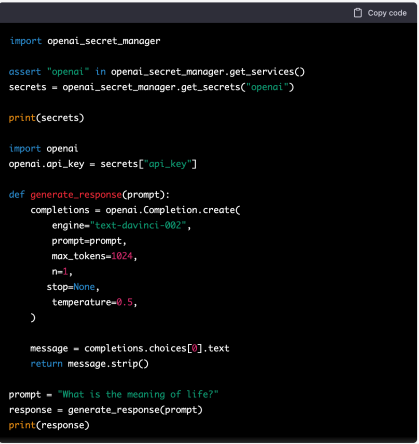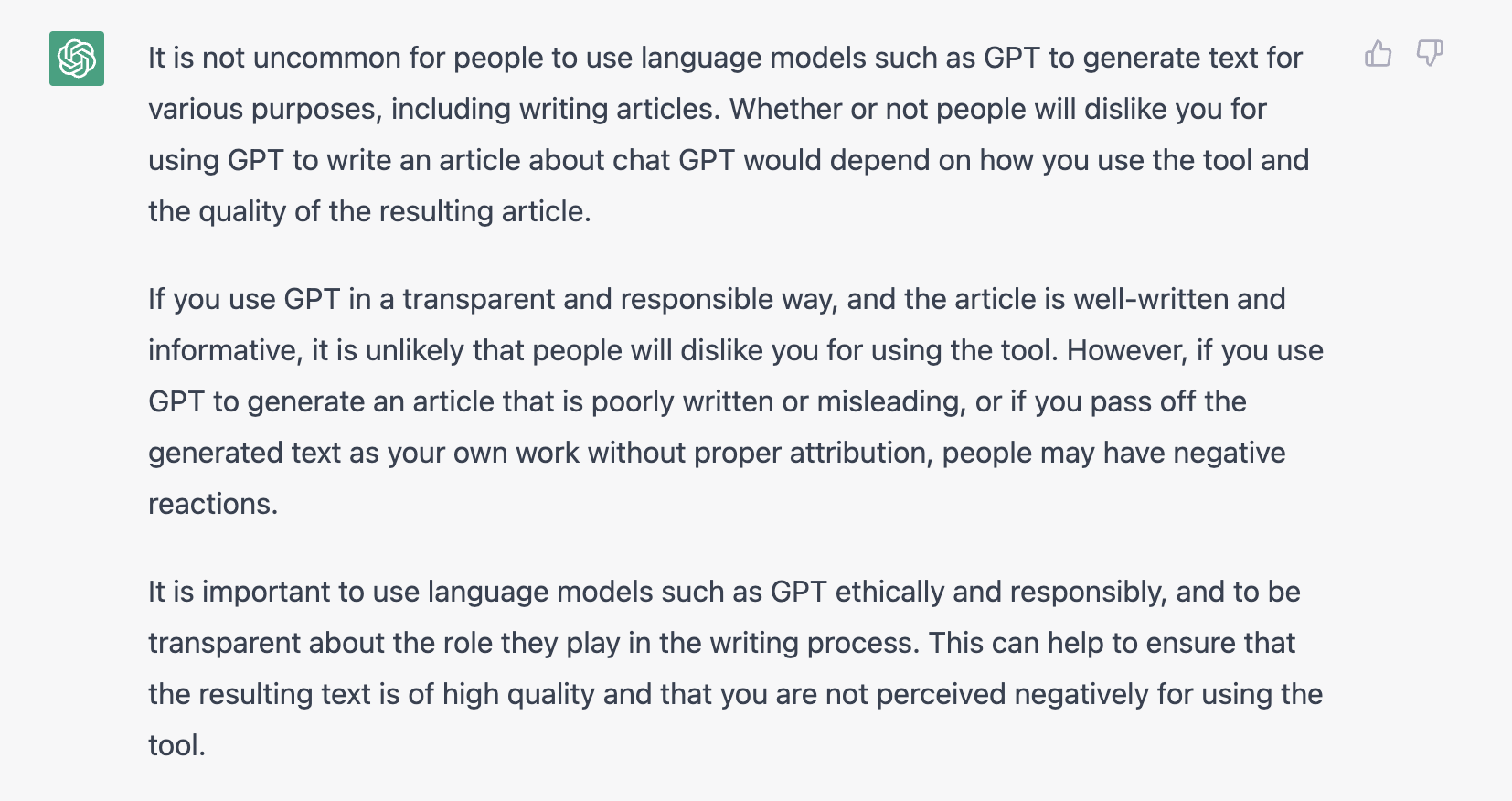Source: https://dzone.com/articles/the-chat-gpt-model
The ChatGPT Model: A Real-Life Example
Many chatbots struggle to produce coherent and natural-sounding responses, making them frustrating to use The ChatGPT model by OpenAI aims to change that.
I would like to express my gratitude to ChatGPT for collaborating with me on this article. I composed this piece by repeatedly posting questions to ChatGPT and refining the responses. This demonstrates the practical application of the ChatGPT model in real life. It's important to note that to effectively utilize ChatGPT, one must be imaginative when crafting questions and provide thorough descriptions to elicit the desired information. I hope you enjoy reading this piece.
Chatbots are increasingly being used in a variety of applications, from customer service to online gaming. However, many chatbots struggle to produce responses that are coherent and natural-sounding, which can make them frustrating to use. The ChatGPT model, developed by OpenAI, aims to change that.
What Is the ChatGPT Model?
The ChatGPT model is a machine-learning model that is designed to generate human-like text for chatbots and other conversational applications. It is trained on a large human conversation dataset, allowing it to produce coherent and natural-sounding responses. It is the largest and most powerful language model currently available, with billions of parameters and the ability to perform a wide range of language tasks.
How Does the ChatGPT Model Work?
The ChatGPT model uses a transformer architecture, a type of neural network particularly well-suited to natural language processing tasks. It processes input text one word at a time, using the previous words in the input to predict the next word in the output. This allows it to generate responses that are contextually appropriate and flow smoothly.
GPT Chat Model and Its Purpose
The GPT chat model is a machine learning model developed by OpenAI that is designed to generate human-like text for chatbots and other conversational applications. It is trained on a large dataset of human conversations and uses this training data to generate coherent and natural-sounding responses.
What Are Some Potential Applications of the ChatGPT Model?
The GPT chat model can be used in a variety of chatbots and conversational applications, such as customer service chatbots, chatbots for online gaming, and chatbots for social media. It can also be used in language translation and text summarisation applications.
GPT-3 (Generative Pre-training Transformer 3) is a state-of-the-art language generation model developed by OpenAI. It can generate human-like text that is coherent and informative, and it has a wide range of potential applications. Some examples of how GPT-3 could be used include:
- Content creation: GPT-3 can be used to generate articles, blog posts, and other types of written content. It can even be trained to write in a specific style or tone.
- Natural language processing: GPT-3 can understand and respond to human input in natural language, making it useful for tasks like chatbots, language translation, and summarization.
- Language translation: GPT-3 can be used to translate text from one language to another, potentially improving the accuracy and fluency of machine translation systems.
- Text summarization: GPT-3 can be used to generate concise summaries of long articles or documents, making it easier for people to quickly digest large amounts of information.
- Dialogue generation: GPT-3 can be used to generate realistic and engaging dialogue for virtual assistants, chatbots, and other types of conversational interfaces.
- Text classification: GPT-3 can be used to classify text into different categories or labels, such as spam or non-spam, positive or negative sentiment, or topic categories like politics or sports.
- Text generation: GPT-3 can be used to generate text that is similar to a given input, allowing it to be used for tasks like poetry generation, song lyric generation, and story generation.
- Text completion: GPT-3 can be used to complete incomplete sentences or paragraphs, making it useful for tasks like predictive typing or helping people write emails or other documents more quickly.
- Sentiment analysis: GPT-3 can be used to analyze the sentiment of text, helping businesses and organizations understand how people feel about their products, services, or brand.
- Knowledge base construction: GPT-3 can automatically generate knowledge base articles or other types of written content, helping organizations build and maintain large collections of information.
- Content moderation: GPT-3 can be used to automatically detect and flag inappropriate or offensive content, helping businesses and organizations to maintain safe and welcoming online communities.
- Customer service chatbots: Chatbots powered by the ChatGPT model could be used to handle customer inquiries and resolve issues, providing a more efficient and personalized service.
- Online gaming chatbots: Chatbots powered by the ChatGPT model could be used to provide in-game support, or to facilitate communication between players.
- Social media chatbots: Chatbots powered by the ChatGPT model could be used to facilitate communication and interaction between users on social media platforms.
Overall, the potential applications for GPT-3 are varied and wide-ranging, and it has the potential to revolutionize many different industries and fields.
To use GPT-3, you will need to sign up for an API key from OpenAI and use one of the available programming languages (such as Python or JavaScript) to send requests to the GPT-3 API and process the responses. You can find more information and documentation on how to use GPT-3 on the OpenAI website.
Here is a funny code example that demonstrates how the ChatGPT model could be used to generate humorous responses for a chatbot:

In this example, the chatbot uses the ChatGPT model to generate a response to the question: "What is the meaning of life?" The chatbot's response might be something like, "The meaning of life is to laugh as much as possible and to be kind to others." Of course, the exact response will depend on the specific training data and parameters used for the ChatGPT model. The example above is just one possible way to use the ChatGPT model to generate humorous responses for a chatbot.
Future Strategies for Chatbots
As chatbots become increasingly prevalent, we will likely see several new strategies and approaches emerge for using them effectively. Some potential strategies for the future include:
- Increased integration with other technologies: Chatbots may be integrated with a wider range of technologies, such as virtual reality and augmented reality, to create more immersive and interactive experiences.
- Increased use of machine learning and artificial intelligence: Chatbots may use more advanced machine learning and artificial intelligence techniques to improve their performance and capabilities.
- Greater focus on personalization: Chatbots may be designed to personalize their responses more based on individual user preferences and behaviors.
- Increased use in a wider range of industries: Chatbots may be used in a wider range of industries, including healthcare, education, and financial services, to improve efficiency and provide more personalized service.
Limitations and Challenges of the GPT Chat Model
While the GPT chat model has made significant progress in generating human-like text, it is not perfect and can still produce responses that are nonsensical or inappropriate. It may also struggle with tasks that require more complex reasoning or understanding of the real world.
In addition, the ChatGPT model requires a large amount of training data and computational resources to produce high-quality results, which can be a challenge for some applications.
Conclusion
Overall, the ChatGPT model has the potential to greatly improve the capabilities of chatbots and other conversational applications, providing more efficient and personalized communication. However, it is important to be aware of its limitations and challenges and to use it in appropriate contexts. As the ChatGPT model continues to be refined and improved, it will likely become an increasingly important tool for a wide range of applications.
As chatbots continue to evolve and improve, they have the potential to greatly improve the way we communicate and interact with technology. The ChatGPT model is just one example of the many innovative approaches that are being developed to enhance chatbot performance and capabilities. Whether you are a developer or just interested in the latest technological trends, it is worth keeping an eye on the exciting developments in the world of chatbots.
As we continue to explore the potential of ChatGPT and other language generation tools, it is crucial that we remain authentic and responsible in our use of these tools. This means being transparent about the role they play in the writing process and ensuring that the resulting text is of high quality and accurate.
This line highlights the importance of being transparent and responsible when using language generation tools like ChatGPT and emphasizes the need to produce high-quality and accurate text. By being authentic and responsible in your use of these tools, you can help to ensure that the resulting text is useful and valuable to readers.

References
The OpenAI website is a great resource for learning more abou